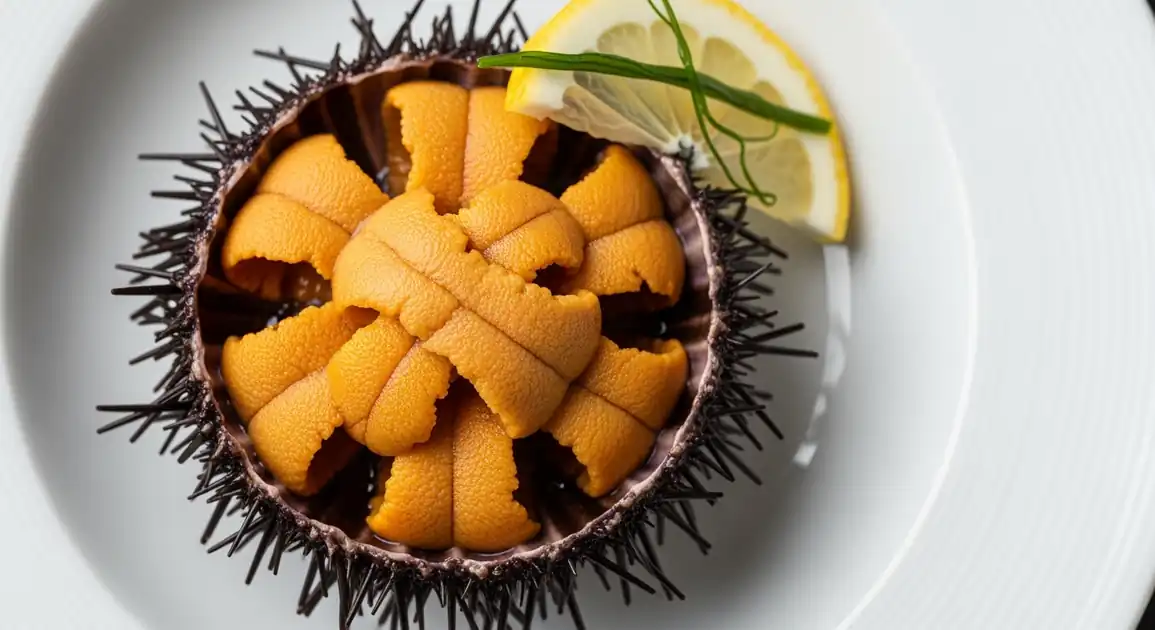Kina (Sea Urchin)
Kina

Description
Auckland, with its extensive coastline and strong Māori cultural presence, offers excellent opportunities to experience fresh kina. As New Zealand's largest city, Auckland features both traditional preparations at markets and cultural events, as well as innovative uses of kina in its diverse restaurant scene. The surrounding Hauraki Gulf provides rich harvesting grounds, though urban pollution concerns make sourcing from trusted vendors particularly important.
Dietary Information
Serving information
Serving style
In Auckland, traditional serving in the shell is common at markets and cultural events. Restaurants often present kina on ice, incorporated into starter dishes, or as a premium ingredient in main courses. Some specialty seafood restaurants serve it as part of comprehensive seafood platters.
Quick facts
Auckland Fish Market: 8 AM - 5 PM (best selection before 12 PM). Specialty seafood stores: typically 9 AM - 6 PM. Cultural markets: variable, often weekends 8 AM - 2 PM. Restaurants serving kina: lunch 12 PM - 2:30 PM, dinner 6 PM - 10 PM.
Safety Tips
What to Look For
-
Bright orange-yellow roe color
The vibrant color indicates freshness; brown, black, or grayish colors suggest deterioration.
-
Clean, ocean-fresh smell
Fresh kina smells like clean ocean water, never fishy or ammonia-like.
-
Firm, intact roe texture
The roe should hold its shape and not be mushy, watery, or granular.
-
Recently harvested
Ideally eaten within 24-48 hours of harvest; ask vendors when it was collected.
-
Proper refrigeration
Kina should be kept cold, either refrigerated or on ice by vendors.
What to avoid
-
Discolored roe (brown, black, gray)
Indicates spoilage; never consume kina with off-colors.
-
Strong fishy or ammonia smell
Clear signs of deterioration; fresh kina has only a mild ocean scent.
-
Mushy or liquefied texture
The roe should not be breaking down or disintegrating.
-
Cloudy liquid in pre-opened kina
The liquid should be clear; cloudiness suggests bacterial growth.
-
Vendors storing kina at room temperature
Proper refrigeration is essential for safety with raw seafood like kina.
Price information
Price range
Budget tips
- Auckland Fish Market in Wynyard Quarter offers whole kina for $8-15 each.
- Pre-opened kina with exposed roe costs more ($15-25 for a serving).
- Restaurant dishes featuring kina can range from $20-35.
- Markets like Otara or specialized seafood stores in South Auckland often have more competitive prices than central city locations.
- Waiheke Island and other gulf islands occasionally have direct-from-harvester sales at lower prices.
Value indicators
- Transparency about harvest location – kina from cleaner waters of outer Hauraki Gulf tends to be superior.
- Visible quality assessment – good vendors allow you to see the product.
- Cultural authenticity – Māori-owned businesses often provide better quality and knowledge.
- Proper storage – displayed on ice or refrigerated.
- Size and weight – heavier kina typically contain more roe.
Where to Find This Dish
Wynyard Quarter
Home to Auckland Fish Market, offering both whole and prepared kina from verified sources.
Auckland Fish Market, Seafood restaurants along North Wharf
Morning, Midday
Mt Wellington
Seafood specialty stores catering to diverse communities often stock fresh kina.
Seafood Central, Mt Wellington Highway shops
Morning, Midday
Otara
The famous Otara Market sometimes features traditional Māori food vendors selling kina.
Otara Market (weekends)
Saturday Morning
Marae Events
Cultural events at Auckland marae occasionally offer traditional kina.
Te Mahurehure Marae, Papakura Marae during cultural events
Various - during special events
Waiheke Island
Some local seafood spots on Waiheke offer fresher, island-harvested kina.
Oneroa shops, Ostend market, Matiatia wharf area
Morning, Midday (weekends)
Vendor Tips
- At Auckland Fish Market, ask for kina from the outer Hauraki Gulf rather than inner harbor areas.
- Build relationships with vendors who will contact you when fresh shipments arrive.
- Ask if they can open the kina for you, both to check quality and for easier consumption.
- At cultural markets, seek vendors who can explain traditional harvesting practices - this often indicates better quality.
How to Order
Regional Variations
-
Gulf Island Kina
(Kina o Tīkapa Moana)
Kina harvested from islands in the Hauraki Gulf (particularly from less populated areas like Great Barrier Island or eastern Waiheke) is often considered superior to mainland-harvested kina due to cleaner waters.
-
Contemporary Auckland Preparations
(Kina Tūmahi Hou)
Auckland's diverse restaurant scene features innovative preparations like kina butter served with fresh bread, kina risotto, or as a luxurious element in seafood platters.
-
Fusion Interpretations
(Kina Hanumi)
Some Auckland restaurants blend Māori traditions with international techniques, creating dishes like kina with Japanese ingredients, kina pasta inspired by Italian cuisine, or kina on modern takes of rewena bread.
Cultural context
History
Kina has been a treasured food source (kaimoana) for Māori for centuries before European settlement. Traditional harvesting was governed by strict protocols (tikanga) ensuring sustainability. Māori would collect kina during seasonal gatherings, often coinciding with lunar cycles. European settlers initially showed little interest in kina, but in recent decades, it has gained wider appreciation in New Zealand's culinary scene, sometimes called 'New Zealand uni' by those familiar with Japanese cuisine. Today, it represents both cultural heritage and a unique local delicacy that bridges traditional and contemporary New Zealand food culture.
Local significance
In Auckland, kina represents a connection to both Māori heritage and the city's coastal identity. It bridges cultural traditions with contemporary cuisine, featuring in both traditional contexts and modern fine dining.
Eating customs
- In traditional settings, eaten directly from the shell, often with minimal accompaniment.
- Growing appreciation in Auckland's culinary scene has led to contemporary serving styles.
- Social media has popularized kina among younger urban Aucklanders, leading to 'foodie' experiences around this traditional food.